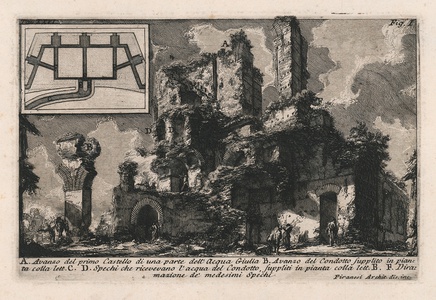| Method | Etching |
| Artist | Giovanni Battista Piranesi |
| Published | Piranesi Archit. dis. inc. [Rome, Bouchard and Gravier, 1756] |
| Dimensions | Image 132 x 200 mm, Plate 135 x 205 mm, Sheet 262 x 415 mm |
| Notes |
Full inscription reads: "A. Avanzo del primo Castello di una parte dell'Acqua Giulia. B. Avanzo del Condotto supplito in pianta colla lett. C. D. Spechi che ricevevano l'acqua del Condotto, suppliti in pianta colla lett. E. F. Diramazione de' medesimi Spechi." Figure 1 of Plate XXVI from the first volume of Piranesi's Antichità Romane, featuring a view of the ruins of the first castella aqua, or distribution tank, of the Julian aqueduct in Rome. The view shows the structure, which once stood near the Colline Gate, in a state of disrepair, with only the piers of the connecting conduit of the aqueduct still standing. The structure, though ruinous and overgrown, has piqued the interest of a group of surveyors, some of whom measure and draw the structure. An inset plan in the top left of the plate shows a schematic of the outlets and channels that redirected water from the main aqueduct into sedimentation tanks before channelling water into five smaller conduits. The Aqua Julia was constructed by Agrippa in 33 BC, under the orders of Augustus, as an extension to the Aqua Tepula, and carried water from springs near Lake Albano to the western suburbs of the city. The Antichità Romane ('Roman Antiquities') was Piranesi's largest, and in many ways most ambitious, series of etchings, comprising 250 plates published in 4 volumes. Unlike the Vedute di Roma, the Antichità Romane is chiefly interested in small details, though the views of principal monuments in this work are no less aesthetically pleasing than the Vedute. Piranesi's agenda as an architect, namely the revival and emulation of classical Roman models, is immediately apparent in his meticulous recording of Rome's architectural and archaeological heritage. As a result, the Antichità Romane became a critical resource for antiquarians and academics. Piranesi's detailed explanations of Roman feats of engineering challenged the emergent argument for the superiority of Classical Greek models in art and architecture. Giovanni Battista (also Giambattista) Piranesi (1720 – 1778) was an Italian artist famous for his etchings of Rome and of fictitious and atmospheric "prisons" (the Carceri d'Invenzione). He was a major Italian printmaker, architect and antiquarian. The son of a Venetian master builder, he studied architecture and stage design, through which he became familiar with Illusionism. During the 1740's, when Rome was emerging as the centre of Neoclassicism, Piranesi began his lifelong obsession with the city's architecture. He was taught to etch by Giuseppe Vasi and this became the medium for which he was best known. Wilton-Ely 328, F193, C26.1 Condition: Clean, dark impression with full margins. Minor foxing to edges of sheet, not affecting plate. |
| Framing | unmounted |
| Price | £200.00 |
| Stock ID | 52583 |

